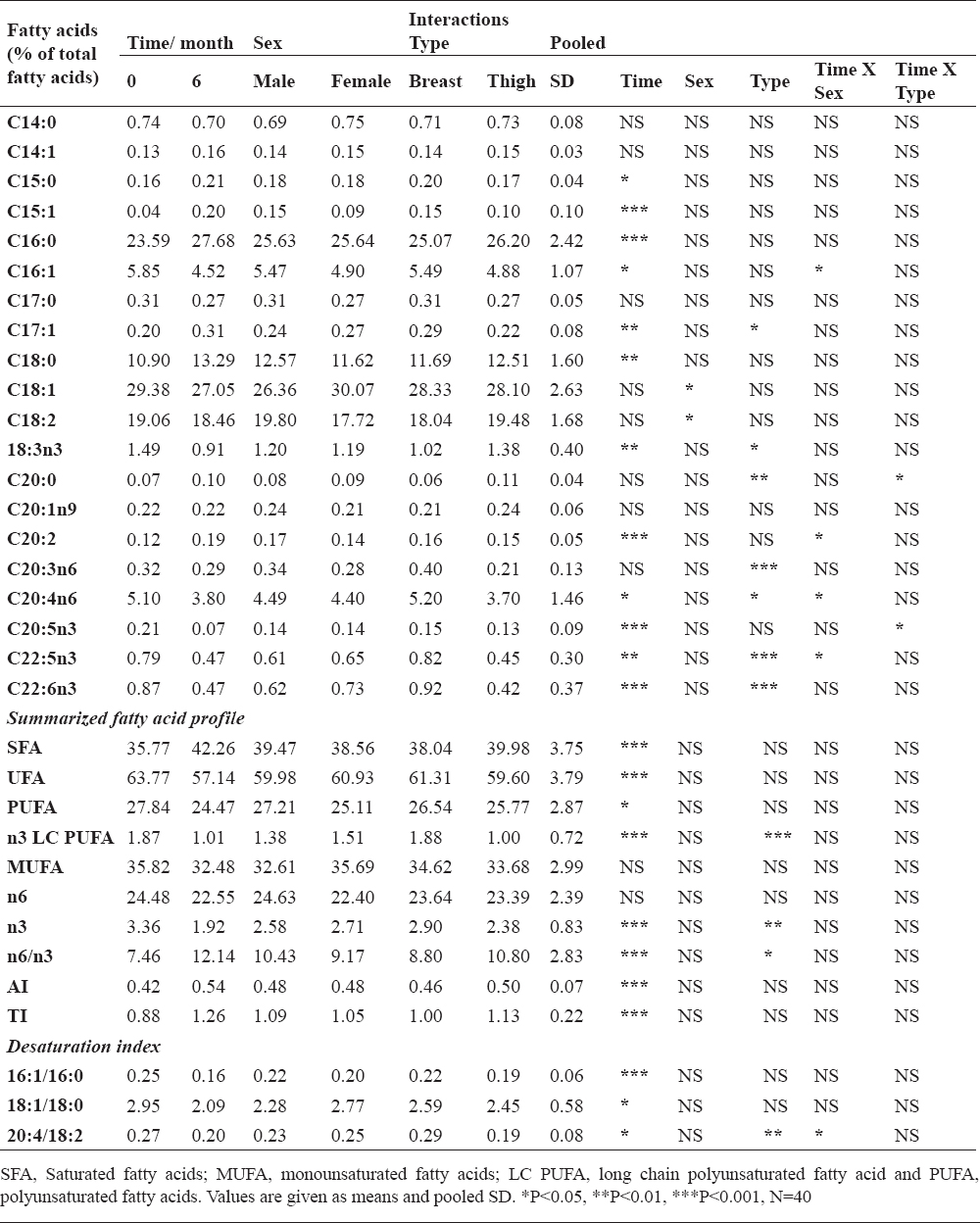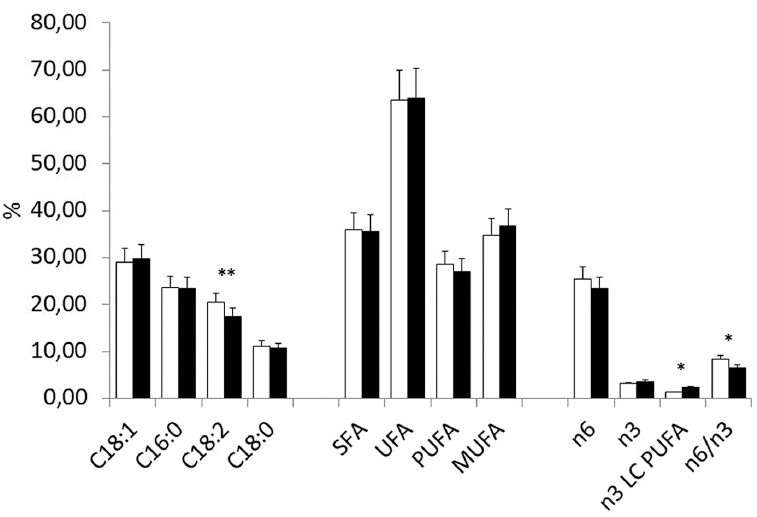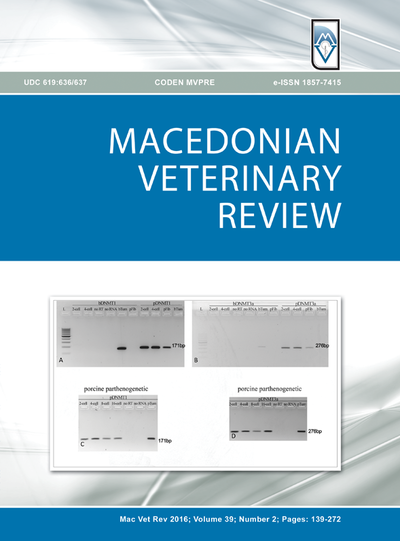INTRODUCTION
Consumers of animal products are becoming more aware of the benefits of a balanced diet for their health (1). Poultry meat is highly valued for its nutritional properties: low fat content and less saturated fatty acid than most ruminant edible tissues. Turkey is one of the leanest types of poultry as well as a good source of protein and minerals, such as sodium, potassium and iron, and it is part of the regular diet in many countries (1). Other important factors responsible for its growing place on the market are its neutral taste and smooth texture (2).
Recently, numerous studies have been performed to investigate the fatty acid composition of poultry meat reared on commercial farms (3, 4). The meat fatty acid composition of poultry depends on the poultry diet, rearing practices and breed (5) and these factors can serve as a tool for manipulation of the fatty acids content. Given the beneficial effects of n3 fatty acids on human health, research has been focused on offering consumers meat enriched with n3 fatty acids (5, 6). Nevertheless, lipid oxidation of unsaturated fatty acids is a major cause of meat quality deterioration, which lowers the functional, sensory and nutritive value of meat products, and therefore, consumer acceptability (7).
Very few data on meat fatty acid composition of indigenous breeds have been reported in the literature, despite the well-known fact that meat from free range bred animals is often perceived to be healthier by the public (8). The Dalmatian turkey is an indigenous type of poultry in the Dalmatian region of Croatia (9). This form of turkey has been developed over the centuries as a result of the local harsh conditions (9). Due to its adaptation to the surroundings and its disease resistance, the Dalmatian turkey could be considered as “old fashioned poultry” of the Mediterranean climate and was a part of a project “Dalmatian Turkey - phenotypic parameters and ecological characteristics of the area” of the Ministry of Agriculture, Fisheries and Rural Development of the Republic of Croatia for the preservation of autochthonous Croatian breeds of domestic animals.
Although this breed of turkey is important for the local community and gene preservation programs, no data on the chemical composition and fatty acid profile of the free-range bred Dalmatian turkey meat exists. Accordingly, this study was undertaken with the objective to investigate the growth performance, meat chemical composition and fatty acid profile of edible meat, as well as to assess the potential of this turkey breed for further improvement via dietary and rearing manipulation. There are limited numbers of studies of frozen storage (10) available in the literature on lipid oxidation in turkey meat and the impact on the fatty acid profile; therefore we investigated the effect of long frozen storage (6 month) on the fatty acid profile in turkey thigh and breast meat.
MATERIAL AND METHODS
Animals, growth performance and body parts measurements
In the present study, 40 turkeys - 20 males and 20 females were used. The study was conducted under the usual conditions of rearing and management of flocks in the local communities of the Dalmatian hinterland (Fig. 1).
Figure 1. Geographical location (red circles) of experimental farms in the Dalmatian hinterland
The feeding program consisted of a standard turkey starter during the first two months and afterwards the diets of the free range birds consisted of scarce pasture, various cereals and vegetable remains. During the experiment, the birds were individually weighed. Body weight (BW) was recorded at the beginning, after 16 weeks and then every six weeks till the end of the study which lasted for 28 weeks. The animals were stunned at 28 weeks of age, slaughtered, bled and plucked in a commercial slaughterhouse. The carcasses were chilled at 4°C for 24 h. The day after, the left sides of the carcasses were quartered according to the Hahn and Spindler (11) cutting method. The composition of each part was calculated as the weight of each tissue component per unit sum of all the dissected components (12). The samples of breast (m. pectoralis superficialis) and thigh muscle (m. iliotibialis cranialis) were then split in two groups, one was frozen at -18 ºC and kept for 6 months and the second was frozen at -80ºC and analyzed within three days.
Determination of chemical composition of breast and thigh muscle
The tissue samples of breast (m. pectoralis superficialis) and thigh muscle (m. iliotibialis cranialis) were minced through a 3.0 mm plate using a kitchen-type mincer to obtain homogeneous samples. Protein, ash and moisture contents were estimated according to recommended methods (13). Two replicates of each sample were analyzed and the mean value was used in the data analyses.
Gas chromatography analysis
Muscle fat content for fatty acid analyses was extracted with a chloroform and methanol mixture (2:1, v/v) (14) at 0 month and six months. The fatty acids were analyzed as their methyl esters, after transesterification with a 2M KOH solution in methanol. Analysis of fatty acid was performed on GC2010Plus Gas Chromatograph (Shimadzu, Japan) equipped with a flame-ionization detector. The capillary column used was ZB WAX (Phenomenex, Torrance, CA, USA), 30 m x 0.25 mm with film thickness of 0.25 μm. The injector temperature was set to 250°C and 1 μl of each sample was injected with a split ratio 1:15. Helium was used as the carrier gas and the detector temperature was set at 300°C. The oven program was as follows: the initial temperature was set at 60°C for 2 min, then increased at the rate of 13°C/min up to 150°C, then increased at 2°C/min up to 220°C, increased at 2°C/min to 240°C and held at 10°C. All the experimental measurements were repeated three times and the average values reported. The quantification was carried out through area normalization with an external standard mixture of fatty acid methyl esters (Sigma–Aldrich, Steinheim, Germany). Fatty acid composition was calculated as a percentage of each individual fatty acid relative to total fatty acids.
Atherogenicity and thrombogenicity indices
Indices of atherogenicity (AI) and thrombogenicity (TI) were calculated as the relationship between the major saturated fatty acids and the main classes of unsaturated fatty acids. The following equations were applied (15):
Statistical analysis
Data was analyzed using the Statistical software (STATISTICA 2010 program, Tulsa, OK, USA). All results were presented as means and standard deviation. The model included sex (female or male), meat type (breast or thigh) and time of storage (0 or 6 months) as factors, and the interaction between these three factors. Statistical differences among the groups were tested by analysis of variance (ANOVA), and Tukey’s test was applied in order to determine statistical differences between group means. Significance was determined at P<0.05.
RESULTS
The growth performance of indigenous Dalmatian turkey is presented in Figure 2. The birds were regularly monitored by a local veterinarian. During the trial, no deleterious effects on health were observed.
Figure 2. Growth curve of male and female experimental turkeys (mean and SD), □Male, ■Female, — Male (N=20), — Female (N=20)
The final live weight for the male and female animals was 4.3 ± 0.4kg and 3.7 ± 0.5kg, respectively. The dressing percentage, drumstick, thigh and breast weight are given in Table 1.
Table 1. Body parts measurements
Weight of male drumstick, thigh and breast were higher than of female ones. The aforementioned is in accordance with Ekert Kabalin et al. (8).
The influence of gender on the chemical composition of turkey meat was noted for dry matter (DM) (P<0.001), protein (P<0.001) and fat content (P<0.05) with female turkeys having higher DM and protein and lower fat content (Table 2). Meat type also influenced DM (P<0.01), protein (P<0.001) and fat content (P<0.001). Higher content of DM and protein and lower of fat were found in breast meat compared to thigh meat. The interaction between sex and meat type was found only for fat content (P<0.01). No differences were found for any of the mentioned factors in ash content (Table 2).
Table 2. Influence of gender and meat type on chemical composition of breast and thigh meat
The influence of time of storage, sex and meat type on fatty acid profile is presented in Table 3 and Figure 3.
Table 3. Influence of gender, meat type and storing time on fatty acid composition of breast (m. pectoralis superficialis) and thigh (m. iliotibialis cranialis)
Figure 3. Predominant fatty acids, summarized fatty acid profile and n3, n6 ratios average values for female and male turkeys (mean and SD), □Thigh, ■Breast. *P<0.05, **P<0.01
After being stored for 6 months, C15:0 (P<0.05), C15:1 (P<0.001), C16:0 (P<0.001), C17:1 (P<0.01), C18:0 (P<0.01), C20:2 (P<0.001), SFA (P<0.001), n6/n3 ratio (P<0.001), AI (P<0.001) and TI (P<0.001) had higher values, while C16:1 (P<0.05), C18:3n3 (P<0.01), C20:4n6 (P<0.05), C20:5n3 (P<0.001), C22:5n3 (P<0.01), C22:6n3 (P<0.001), UFA (P<0.001), PUFA (P<0.05), n3 LC PUFA (P<0.001), n3 (P<0.001) and calculated desaturation indices (P<0.001 for 16:1/16:0, P<0.05 for 18:1/18:0 and 20:4/18:2) had lower ones. Sex had effect only on two fatty acids. Female turkeys had lower C18:1 and higher C18:2 than male ones (P<0.05). Breast muscle had higher C17:1 (P<0.05), C20:3n6 (P<0.001), C20:4n6 (P<0.05), C22:5n3 (P<0.001), C22:6n3 (P<0.001), n3 LC PUFA (P<0.001), n3 (P<0.01) and 20:4/18:2 desaturation index values (P<0.01) than thigh muscle. The higher values of C18:3n3 (P<0.05), C20:0 (P<0.01) and n6/n3 ratio (P<0.05) was observed in thigh muscle in comparison to breast muscle. Interaction of time and sex had impact on C16:1, C20:2, C20:4n6, C22:5n3 and 20:4/18:2 index (P<0.05), whereas time and meat type interaction was found only for FAs C20:0 and C20:5n3 (P<0.05).
DISCUSSION
It is well known that fast-growing birds are mainly used in commercial turkey production, while slow growing birds are selected by farmers for organic and free range production (16, 17). Hence, the final weights of turkeys in this study were significantly lower than the weight of commercial turkey hybrids. When different genotypes were reared for 25 weeks in free range systems, growth performance was related to the strains with values 5.0 to 6.3 kg, 8.2 to 10.9 kg and 7.6 to 9.2 kg, for slow growing (American Bronze turkey), fast growing (Hybrid converter) and crosses, respectively (4). Our results for growth performance (Fig. 2) are similar to those for American Bronze, which is a slow growing genotype. The dressing percentage values of indigenous Dalmatian turkey (Table 1) were in accordance with the values for American Bronze turkeys and wild turkeys (18).
As seen also from Table 2, DM, protein and fat contents of raw turkey meat were affected by sex as well as by meat type. Concerning influence of meat type, our results are in accordance to Sarica et al. (4). The aforementioned authors (4) did not see any influence of sex, while we found significant differences between male and female. The significantly higher values for protein and lower values for fat in female birds were observed. These unusual results could be influenced by sexual differences in feed intake in free choice feeding systems, and by hierarchy.
The fatty acid composition of the turkey meat in our trial was characterized by the predominance of n6 fatty acids, especially C18:2n6 and high n6/n3 ratio (Table 3, Fig. 3). This ratio is an indicator of the balance between the two fatty acid lines entering the food chain (19). A large increase in n6 fatty acids in diet and decrease of EPA and DHA has been associated with inflammatory diseases and obesity (19). Concentrations of C18:2n6 in our trial were significantly lower for female birds, which is in concordance with the results for turkeys in conventional rearing systems (20). The influence of meat type on C18:2n6 was not observed in our study, while other authors observed significant influence of meat type (21).
The most obvious influence on beneficial n3 fatty acids was the time of storage (22). Freezing is one of the most important preservation methods for meat and meat products. Compared with other methods it leads to a minimal loss of quality during long-term storage (6 months) (22). Poultry meat is susceptible to oxidative reactions due to their high concentrations of oxidation catalysts (such as myoglobin and iron) and lipids (23). Lipid oxidation proceeds through a typical self-propagating free radical mechanism where oxygen attack occurs mainly at the allylic positions adjacent to double bonds (24). An increase in time of storage strongly reduced the beneficial long chain polyunsaturated fatty acid (LC PUFA = EPA+DPA+DHA) content, which led to worsening AI and TI (Table 3). The content of n3 PUFA was also influenced by meat type, with lower values of C18:3n3 and higher values of LC PUFA in the breast compared to the thighs.
The potential intakes of LC PUFA in our trial would be lower in comparison to modern poultry fed complete feed mixtures (25). Although, it is interesting that in our trial DHA values were higher in comparison to DPA values. Wang et al. (26) reported that ‘old fashioned’ poultry meat has higher DHA values compared to DPA, while modern poultry has lower DHA values compared to DPA. They speculated that this change may be a consequence of rapid growth in modern birds and the decreased capacity of tissues for DHA synthesis. On the basis of the DHA/DPA ratio, it could be assumed that the LC PUFA content of Dalmatian turkey tissues could be further improved by dietary manipulation. The content of fatty acids in different tissues is influenced by diet, de novo synthesis or bioconversion of linolenic acid (LNA; 18:3n3) and 18:2n6 to corresponding LC PUFA. The lipid deposition in edible tissues is influenced by the efficiency of FA conversion in liver (27). Muscle tissue does not have important desaturation and elongation activity, therefore, muscle DHA/DPA ratio depends on the liver lipogenesis. Future investigations should focus on the differences in liver fatty acid metabolism between modern hybrids and archaic breeds. There is an important difference in diet composition and feed presentation between “old fashioned poultry”, which is nowadays generally reared in organic production systems, and modern breeds, which are kept in intensive production. The higher content of LC PUFA in organic poultry tissues is the most frequent consequence of high intakes of green forage, with a higher content of n3 (3). In our trial, experimental Dalmatian turkeys only had access to fresh grass in spring because of the droughts that characterize the local climate during the summer. A commercially feasible feeding program for the local community during the summer period requires a feed that does not contain adequate amounts of LC PUFA or LC PUFA precursors (olive leaves, insects, dry grass and agricultural byproducts). In several investigations LC PUFA content was higher in intensive production compared to organic farming (28). This is the consequence of the fact that high C18:3n3 diets in organic production do not always lead to higher LC PUFA contents in edible tissues, because of competition for rate-limiting desaturase enzymes (29). Although green forage rich in C18:3n3 is not part of the diet in intensive production systems, high LC PUFA values are caused by dietary manipulations with oils, oil seeds or marine products high in n3 (22).
CONCLUSION
The future of Dalmatian turkey breeding lies in a sensitive balance between socially vulnerable local communities and highly demanding consumers concerned for their health. The use of local types of poultry in a breeding program should be encouraged because they are better adapted to the local environment and have been shown to have better disease resistance. Dalmatian turkeys have a well adapted and disease resistant genotype, and in combination with minimal dietary intervention (an increase in LC PUFA precursors and/or use of local vegetation rich in polyphenols) could easily be transformed into a financially feasible product with additional health promoting functions.













